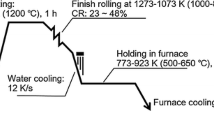Abstract
AP1000 primary coolant pipes must be manufactured by integral forging technology according to the designer—Westinghouse Electric Co. The characteristics of these large, special-shaped pipes create nonuniform temperatures, effective stress, and effective strain during sha** of the pipes. This paper presents a three-dimensional finite element simulation (3D FEM) of the integral forging process, and qualitatively evaluates the likelihood of forging defects. By analyzing the evolution histories of the three field variables, we concluded that the initial forging temperature should be strictly controlled within the interval 1123 K to 1423 K (850 °C to 1150 °C) to avoid second-phase precipitation. In the hard deformation zones, small strains do not contribute to recrystallization resulting in coarse grains. Conversely, in the free deformation zone, the large strains can contribute to the dynamic recrystallization, favoring grain refinement and closure of voids. Cracks are likely to appear, however, on the workpiece surface when forging leads to large deformations. Based on the simulation results, an eligible workpiece with good mechanical properties, few macroscopic defects, and favorable grain size has been successfully forged by experiments at an industrial scale, which validates the FEM simulation.
















Similar content being viewed by others
References
T.L. Schulz: Nucl. Eng. Des., 2006, vol. 236, pp. 1547-57.
H.C. Wu, B. Yang, S.L. Wang, and M.X. Zhang: Mater. Sci. Eng. A, 2015, vol. 633, pp. 176-83.
H. Cho, B.K. Kim, I.S. Kim, and C. Jang: Mater. Sci. Eng. A, 2008, vol. 476, pp. 248-256.
E.I. Samuel, B.K. Choudhary, and K.B.S. Rao: Scripta Mater., 2002, vol. 46, pp. 507-12.
P.P. Li, Y.X. Zhong, and Q.X. Ma: Met. Forming Equip. Manuf. Technol., 2011, vol. 42, pp. 13-17.
X.W. Duan, and J.S. Liu: Mater. Sci. Eng. A, 2013, vol. 588, pp. 265-71.
X.W. Duan, and J.S. Liu, X.H. Zheng, Z.G. Hei: J. Plast. Eng., 2012, vol. 20, pp. 60-64.
P.P. Li, Y.X. Zhong, Q.X. Ma, and C.L. Yuan: J. Tsinghua Univ. (Sci. & Tech.), 2013, vol. 3, pp. 289–94.
P.P. Li, Y.X. Zhong, Q.X. Ma, C.L. Yuan, and J.P. Luo: J. Plast. Eng., 2011, vol. 18, pp.13-18.
P. Pan, Y. Zhong, Q. Ma, and C. Yuan: Chin. J. Mech. Eng., 2013, vol. 49, pp. 97-102.
Z.J. Zhang, G.Z. Dai, S.N. Wu, L.X. Dong, and L.L. Liu: Mater. Sci. Eng. A, 2009, vol. 499, pp. 49-52.
M.S. Chen, and Y.C. Lin: Int. J. Plasticity, 2013, vol. 49, pp. 53-70.
W. Weroński, A. Gontarz, and Z. Pater: J. Mater. Process Tech., 1999, vol. 92, pp. 50-53.
Y.H. Moon, C.J. Van Tyne, and W.A. Gordon: J. Mater. Process Technol., 2000, vol. 99, pp. 169-78.
Y.H. Moon, C.J. Van Tyne, and W.A. Gordon: J. Mater. Process Technol., 2000, vol. 99, pp.179-84.
Y.H. Moon, and C.J. Van Tyne: J. Mater. Process Technol., 2000, vol. 99, pp. 185-96.
S.K. Choi, M.S. Chun, C. Van Tyne, and Y.H. Moon: J. Mater. Process Technol., 2006, vol. 172, pp. 88-95.
D. Qian and Y. Pan: Comp. Mater. Sci., 2013, vol. 70, pp. 24-36.
S.F.T.C., DEFORMTM 3D Version 6.1 (sp1) User’s Manual, Scientific Forming Technologies Corporation, Columbus, Ohio, 2007.
C.A.M.H.E. Committee, China Aeronautical Materials Handbook (Structural Steel, Stainless Steel), China Standard Press, Bei**g, 2002, pp. 542–48.
A. Parvizi, K. Abrinia and M. Salimi: J. Mater. Process Technol., 2011, vol. 20, pp. 1505-11.
C.Y. Park and D.Y. Yang: J. Mater. Process Tech., 1997, vol. 67, pp. 195-200.
X.Z. Zhang, Y.S. Zhang, Y.J. Li, and J.S. Liu: Mater. Sci. Eng. A, 2013, vol. 559, pp. 301-06.
W. Reick, M. Pohl, and A.F. Padilha: ISIJ Int., 1998, vol. 38, pp. 567-71.
H. Miyamoto, T. Mimaki, and S. Hashimoto: Mater. Sci. Eng. A, 2001,vol. 319, pp.779-83.
V.G. Gavriljuk, and H. Berns, High Nitrogen Steels (Structure Manufacture Application), Berlin: Springer verlag Berlin,1999, pp. 82-85.
Y. Maehara, K. Masao, and N. Fu**o: Trans ISIJ., 1983, vol. 23, pp. 240-46.
J.O. Nilsson: Mater. Sci. Technol., 1992, vol. 8, pp. 685-700.
Acknowledgments
The authors are grateful for the support of the State Key Laboratory for Advanced Metal Materials and Collaborative Innovation Center of Steel Technology at the University of Science and Technology, Bei**g, the “863” Program of China under Project No. 2012AA03A507.
Author information
Authors and Affiliations
Corresponding author
Additional information
Manuscript submitted September 2, 2015.
Rights and permissions
About this article
Cite this article
Wang, S., Yu, X., Yang, B. et al. FEM Analysis and Experimental Verification of the Integral Forging Process for AP1000 Primary Coolant Pipe. Metall Mater Trans A 47, 5114–5124 (2016). https://doi.org/10.1007/s11661-016-3696-z
Published:
Issue Date:
DOI: https://doi.org/10.1007/s11661-016-3696-z




